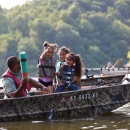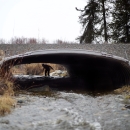States
ArizonaThis project builds on the decades of devoted efforts among federal, state, Tribal, and non-governmental organizations to restore aquatic connectivity and organism passage in the headwaters of the Salt River Basin and adjacent Little Colorado River watershed. Efforts led by the White Mountain Apache Tribe to remove physical and thermal barriers on Tribal lands and national forests were critical in the recent delisting of Apache trout from the List of Endangered and Threatened Wildlife. Restoring aquatic connectivity will enhance ecosystem resilience to climate change climate change
Climate change includes both global warming driven by human-induced emissions of greenhouse gases and the resulting large-scale shifts in weather patterns. Though there have been previous periods of climatic change, since the mid-20th century humans have had an unprecedented impact on Earth's climate system and caused change on a global scale.
Learn more about climate change by enabling fish populations to expand into new habitat as conditions change over time. Additionally, wet meadow restoration in headwater habitats will contribute to fire and drought resilience in the ecosystem.
Project Quick Facts:
- Location: Arizona
- Federal Investments to Date: $5,000,000
- Non-Federal Investments to Date: $4,000,000
- Total Restoration Costs: $19,000,000
- Type of Barriers: Dams, Culverts, Hydrologic
- Number of Barriers: 29
- Stream Miles Reopened: 174
- Acres Restored: 169
- Project Leads: White Mountain Apache Tribe, U.S. Fish and Wildlife Service, State of Arizona, U.S. Forest Service
- Partners Include: Trout Unlimited, Salt River Project, Freeport McMoRan
- Federal Agencies Invested to Date: U.S. Fish and Wildlife Service, U.S. Forest Service, Bureau of Reclamation
Removing Barriers to Success
Ongoing partnership and collaborative investment, catalyzed by the BIL, are crucial to safeguarding the Apache trout’s status and advancing habitat restoration for this species and other sensitive species, such as the Loach minnow.
The Importance of Transformational Fish Passage Projects
This project is one of over 70 grand-scale, community-centric restoration projects, identified by the Federal Interagency Fish Passage Task Force, that not only rejuvenate ecosystems but also bolster the climate resilience and economies of communities across the country. Learn more about these ground breaking projects in our Reviving Rivers, Reconnecting Communities story map.
The National Fish Passage Program combines technical expertise with a track record of success.
Implemented primarily through the Service's Fish and Wildlife Conservation Offices, the National Fish Passage Program provides financial and technical assistance to partners across the country. Since 1999, the program has worked with over 2,000 local communities, Tribes, and private landowners to remove or bypass over 3,400 barriers to fish passage fish passage
Fish passage is the ability of fish or other aquatic species to move freely throughout their life to find food, reproduce, and complete their natural migration cycles. Millions of barriers to fish passage across the country are fragmenting habitat and leading to species declines. The U.S. Fish and Wildlife Service's National Fish Passage Program is working to reconnect watersheds to benefit both wildlife and people.
Learn more about fish passage and reopen access to over 61,000 miles of upstream habitat for fish and other animals. Staff have expertise in fish migration and biology as well as financial, engineering, and planning assistance to communities, Tribes, and landowners to help them remove barriers and restore rivers for the benefit both fish and people.
Fish passage project proposals can be initiated by any individual, organization, government, or agency. However, proposals must be submitted and completed in cooperation with a Fish and Wildlife Conservation Office. (Please note that fish passage projects being used for federal or state compensatory mitigation or required by existing federal or state regulatory programs are not eligible for funding through the National Fish Passage Program.)
CONTACT A FISH PASSAGE COORDINATOR IN YOUR AREA TO GET STARTED.





